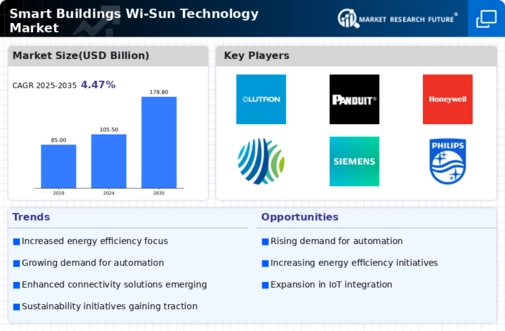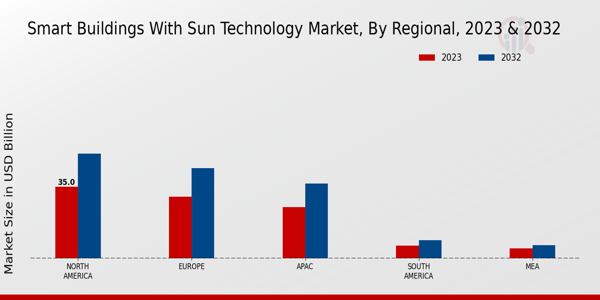Market Growth Projections
The Global Smart Buildings Wi-Sun Technology Market Industry is poised for substantial growth, with projections indicating a market value of 105.5 USD Billion in 2024 and an anticipated increase to 178.8 USD Billion by 2035. This growth reflects a compound annual growth rate (CAGR) of 4.92% from 2025 to 2035. Such projections underscore the increasing adoption of smart technologies in buildings, driven by factors such as energy efficiency, regulatory support, and consumer demand. The market's expansion is indicative of a broader trend towards sustainable and intelligent building solutions, positioning Wi-Sun technology as a key player in the future of smart infrastructure.
Regulatory Support and Incentives
Regulatory frameworks and government incentives play a crucial role in shaping the Global Smart Buildings Wi-Sun Technology Market Industry. Many countries are establishing policies aimed at promoting smart building technologies to meet sustainability goals. For instance, tax incentives and grants for energy-efficient upgrades encourage building owners to invest in Wi-Sun technology. These initiatives not only foster innovation but also stimulate market growth. As governments commit to reducing carbon emissions, the demand for smart building solutions is expected to rise, further enhancing the market's potential. This supportive regulatory environment is likely to be a key factor in achieving the projected market value of 178.8 USD Billion by 2035.
Advancements in IoT and Connectivity
Technological advancements in the Internet of Things (IoT) and connectivity are pivotal drivers for the Global Smart Buildings Wi-Sun Technology Market Industry. The proliferation of IoT devices enables seamless communication between various building systems, enhancing operational efficiency and user experience. Wi-Sun technology, characterized by its low-power, wide-area network capabilities, supports the connectivity of numerous devices over large distances. This is particularly beneficial in urban environments where building density is high. As the market evolves, the integration of advanced connectivity solutions is likely to facilitate the development of smarter, more responsive buildings, thereby attracting significant investment.
Growing Demand for Energy Efficiency
The Global Smart Buildings Wi-Sun Technology Market Industry experiences a notable surge in demand for energy-efficient solutions. As urbanization accelerates, buildings account for a significant portion of global energy consumption. The integration of Wi-Sun technology facilitates real-time monitoring and management of energy use, leading to reduced operational costs. In 2024, the market is projected to reach 105.5 USD Billion, driven by the need for sustainable building practices. Governments worldwide are implementing regulations that encourage energy efficiency, further propelling the adoption of smart technologies in buildings. This trend is expected to continue, with the market anticipated to grow at a CAGR of 4.92% from 2025 to 2035.
Increased Focus on Building Automation
The increasing emphasis on building automation significantly influences the Global Smart Buildings Wi-Sun Technology Market Industry. Automation technologies streamline operations, enhance security, and improve occupant comfort. Wi-Sun technology enables the integration of various building systems, such as lighting, HVAC, and security, into a cohesive management platform. This integration not only optimizes resource use but also provides valuable data for decision-making. As organizations recognize the benefits of automation, investment in smart building technologies is expected to rise. This trend aligns with the broader shift towards digital transformation in the construction and real estate sectors, indicating a robust growth trajectory for the market.
Consumer Awareness and Demand for Smart Solutions
Consumer awareness regarding the benefits of smart building solutions is a driving force in the Global Smart Buildings Wi-Sun Technology Market Industry. As individuals become more informed about energy savings, enhanced comfort, and improved security, the demand for smart technologies in residential and commercial buildings increases. This heightened awareness is complemented by the growing availability of smart devices and applications that simplify the management of building systems. Consequently, property developers and owners are increasingly adopting Wi-Sun technology to meet consumer expectations. This trend is likely to contribute to the market's growth, as more stakeholders recognize the value of investing in smart building solutions.
















